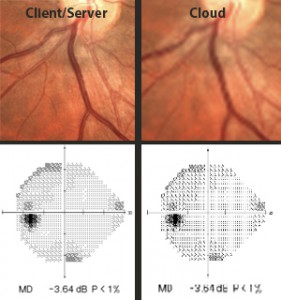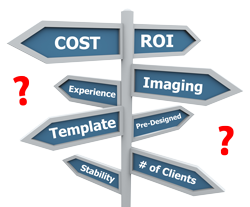Several Ophthalmology EMR/EHR’s are now cloud/web based. With all the recent hype of “the cloud”, fancy lingo like “it’s the future”, and claims of lower upfront costs and less IT concerns, why not go web based? Web-based software is a great option to have for certain tasks. In fact, a few of the features in our software utilize this technology. Although the concept can be mutually beneficial and works great for your lightly used disposable computers, iPhones, and on the go sales agents… a completely web-based EMR is not for everyone, and before you dive head first, consider the many drawbacks including:
- Once you are in, you can’t get out
- Poor Imaging Study Quality, Performance & Usability
- Lack of Ownership & Control
- Cost
- You’ll Still Need a Server
- Poor Performance
- Reduced Integration Flexibility to Practice Management Systems and Ophthalmic Diagnostic Test Machines
- Security
- Outages & Reliability
- Lack of Features & Cumbersome Internet Browser Interface
Once you are in, you can’t get out 
When on a cloud system, all your data is physically located in THEIR servers. Rest assured that they will hold your data hostage in the event you try to switch EMR vendors. Many cloud vendors try to make you feel like you can leave whenever you want by offering “No-Commitment” contracts. In reality, they know they have your data and you aren’t going anywhere once you are dependent on them so they don’t have to bind you with any written agreements.
Some vendors try to minimize this issue by assuring you that if you switch (or they go out of business) they will provide you with a CD with all of your “data” in it. Some vendors will even charge you hundreds to thousands of dollars for it. In any case, even if they provide a data CD, you will likely not be able to do much with it as it will not be in a usable format unless you pay a data conversion company tens of thousands of dollars to convert and import that data to the new EMR system. If you switch EMR’s, when you realize that you cannot do anything with that data, you will likely end up having to pay them “Chart Access” fees to access their system so that you can at least review your charts. With most Client/Server EMR systems, if you switch the vendor may not continue to support you, but you will still have indefinite access to your charts. Even if you want to leave the cloud vendor, you will likely stay with them and continue to use an inferior system because you can’t get out.
Poor Imaging Study Quality, Performance & Usability
Although cloud EMR’s may work well for many medical specialties, cloud EMR’s negatively impact Ophthalmologists. Ophthalmology is one of only a handful of medical specialties that rely heavily on high-resolution imagery. Because of the bandwidth limitations cloud vendors have to work with, many cloud vendors resample images to much lower resolutions in order to deliver them more quickly. Although this practice will certainly result in improved delivery times, it comes at the cost of quality and usability. Zooming into resampled images reveal details lost to pixelation and compression blur. Will these lost details affect your ability to interpret the images?
Although most cloud EMR’s with imaging capabilities have at least the ability to display images, they usually are feature limited. Quickly zooming in and out of high-resolution images, panning, and browsing through tomography’s with 50+ frames with a flick of a mouse wheel are features most cloud EMR’s can only dream of having someday in the future.
Lack of Ownership & Control
With web-based EMR’s, data is not yours. Your EMR is not your EMR. It is their EMR, and they are letting you use it. You are not free to explore your raw data however you wish, you are at their mercy and their control. They can lock you out of their system for any reason they see fit, and you will never lose your dependency on them.
Apple co-founder Steve Wozniak said, “I think there are going to be horrible problems (caused by the cloud) in the next five years.” View News Article Your data is located on the same database server hundreds if not thousands of other users are using. Many Cloud vendors data mine your blinded clinical data and make huge profits selling it to other companies. Will they share the profits with you? HIPAA does not protect you from blinded clinical data collection. The government wants your data, and so does everyone else. You will have no control over what is done with your data, they have the data and the keys, and it is valuable. Cloud vendors can update their system at any moment, instantaneously affecting hundreds if not thousands of users. Will they always do it right? How many times will they adversely effect their entire user base? With Client/Server, you will receive updates as you are ready for them. Updates will be forced on you if you are web based whether you are ready for it or not. Individual responsibility or big brother? You decide.
Cost
Within 5 short years, a single provider practice will pay 275% more for Web Based EMR’s. The longer on the cloud, the more it hurts your bottom line.Rather than making an investment that will only affect you for a short period of time, you will be bound to a significant recurring monthly expense that will never go away. To add to the expenses, you will still need computers, you will have to pay much more for a reliable internet connection that has both fast download & upload speeds every month, you will need to pay for a backup internet service every month, and you will need to purchase an advanced router that supports failover. If upfront cost is a barrier for you, client/server software and hardware can be leased with 36 or 60-month terms and a $1 buy out, usually for less or near the monthly cost of the cloud. You will physically own the software and data from day 1, and be able to pay it off. Also, the performance issues and lack of features will slow you down, resulting in you not being able to see as many patients. How much will that cost your ophthalmology practice? Can you afford to go down every time your internet goes down?
You’ll Still Need a Server
If you have diagnostic test machines, the only practical way to have fast imaging is to have a local server. Cloud imaging is slower than client/server, and you will likely not realize it until you are invested in it. As a solution to the performance issues, some vendors will imprudently suggest that you get a local server to host the images.
In an attempt to mask the imaging issues created by the cloud, a few cloud-based EMR systems with imaging capabilities rely on workstations to store images so they appear faster and so they can cut down on expensive cloud data storage costs. They assign server responsibilities to a workstation so they can claim that you do not need a server. Although this concept can serve as a band-aid to momentarily increase viewing performance for the initial exam, it creates other issues that are swept under the rug. Over the long haul, storing images on unreliable/unsecured workstations will expose your practice to image retrieval reliability, performance, & security issues. In some implementations, it may put your practice at risk for permanent imaging data loss. Your practice will still need a server for local files unrelated to EMR, to manage your workstation security to ensure HIPAA compliance, and for your Practice Management System. If you still need a server, why go web based?
Poor Overall Performance
![]() Connecting to the Cloud . . .
Connecting to the Cloud . . . ![]() Loading Patient . . .
Loading Patient . . . ![]() Uploading Images . . .
Uploading Images . . . ![]() Loading Images . . . When they demo their software to you, it will be demonstrated in a clean and ideal artificial demo environment, where there is no such thing as latency, outages, oversubscription, and lack of bandwidth. They all “do it better than the next guy”, and all have “worked the kinks out”. Only when you go live will you realize the realities of web-based software, and you will be dramatically slowed down by it. In contrast to other medical specialties, Ophthalmology is adversely affected by cloud systems because of the amount of diagnostic imaging machines. 20 high-resolution Fundus Photos cannot display in real time over the web. Server-side image processing helps, but it is still much slower, especially during peak times when there are large demands on their servers caused by all their users. Waiting for uploads to complete can be agonizing. Some vendors will claim that the files are pre-compressed so they upload/download faster. The reality is that most images are already compressed and will usually not compress much further. To be fair cloud performance has improved, but no matter what they claim, cloud EMR’s are overall slower. If you go web-based, have your patience handy, and reduce the amount of patients you see because you will be slowed down.
Loading Images . . . When they demo their software to you, it will be demonstrated in a clean and ideal artificial demo environment, where there is no such thing as latency, outages, oversubscription, and lack of bandwidth. They all “do it better than the next guy”, and all have “worked the kinks out”. Only when you go live will you realize the realities of web-based software, and you will be dramatically slowed down by it. In contrast to other medical specialties, Ophthalmology is adversely affected by cloud systems because of the amount of diagnostic imaging machines. 20 high-resolution Fundus Photos cannot display in real time over the web. Server-side image processing helps, but it is still much slower, especially during peak times when there are large demands on their servers caused by all their users. Waiting for uploads to complete can be agonizing. Some vendors will claim that the files are pre-compressed so they upload/download faster. The reality is that most images are already compressed and will usually not compress much further. To be fair cloud performance has improved, but no matter what they claim, cloud EMR’s are overall slower. If you go web-based, have your patience handy, and reduce the amount of patients you see because you will be slowed down.
Reduced Integration Flexibility to Practice Management Systems and Ophthalmic Diagnostic Test Machines
Because your clinical system is “on the cloud”, interfacing your existing practice management system and your ophthalmic diagnostic test machines will either be complicated, unreliable, costly, and/or impractical. If the cloud-based provider supports these integrations, all sorts of workarounds and 3rd party tools will have to be implemented to accommodate technology that was not designed to be used in this environment. Costly & difficult to manage VPN’s may have to be setup, and complicated/delicate 3rd party software tools will have to be installed and configured on your unreliable workstations.
If you don’t have a server, the interfaces will go down every time you have a problem with the workstation hosting the software as they do not offer the reliability found on a server. Once setup, the interfaces may not be real-time, creating delays that will force you to hit refresh buttons. As the cloud-based provider grows, the complexities and the wide array of patches and workarounds the provider has done in an attempt to accommodate these integrations may become difficult to manage, leaving your practice exposed to reliability issues. If you outgrow or lose your desire to stay on the PM system offered by your clinical system provider, your Practice Management options will shrink considerably as many of them do not natively support this type of environment.
Security
Can a cloud-based system ever really be secure? When your system is on the cloud, confidential patient & financial data from multiple practices are on a single system that is readily accessible to authorized users through the public internet. One backdoor left open can cause large scale irreversible damage. Hackers find this infrastructure very appealing because of the amount of data on a single system and large scale outages they can potentially cause. As a result, hackers will relentlessly try to find ways to gain access to it. Even if there are no holes in their technology, can they prevent passwords from being leaked through social engineering, which can subsequently lead to unauthorized access through any device on the internet? If Apple iCloud, GoDaddy, and Amazon can get hacked, why not a smaller software company? Keeping your data on your private network behind your firewall is by far more secure, and limits security breaches to a single practice in the unlikely event it does occur.
Technology journalist loses everything on the cloud after getting hacked. View News Article Apple Developer web site shut down by hack attack View News Article
Outages & Reliability
Many cloud vendors claim their system has 99.99% uptime and reliability, and their “economies of scale” make it more reliable and secure than Client/Server. Assuming their claim is accurate, their servers may not go down because of the redundancies they can afford from their end, but on your end, that is just NOT TRUE!
There are other contributors to downtime swept under the rug such as your internet service going out much more frequently, large scale internet problems not affecting them locally, problems they cause “tripping over the wrong wire” on their end, forced updates gone wrong, oversubscription, problems caused by other users that affect you, performance issues during peak times of the day, issues related to internet browser compatibility, toolbars, widgets, add-ons, spyware, adware, the list goes on and on. With Client/Server, you can limit your surface area and will experience far better reliability as long as you choose the right equipment (which we will help you with). You can even achieve data center uptime using our server failover and/or our low-cost real-time server synchronization features. Click here for more information about server synchronization.
GoDaddy DNS outage takes down millions of sites. View News Article
Hacked home devices trigger nationwide internet outage, future attacks eminent. View News Article
Are large scale internet outages the new normal? View News Article
Lack of Features & Cumbersome Internet Browser Interface
Web-based user interfaces are dramatically different than client/server. Although on the surface they are attractive, there are many things not possible or practical in web based software. You will be limited in more ways than one. As the program is based on a web page type interface, is not as fluid as Client/Server and it will annoy you, even if they move the server to your site. Because it is used within an internet browser, toolbars, widgets, add-ons, etc will effect the presentation, ergonomics, & reliability of the EMR. You may not realize this during demos because they are at the wheel, and they clean up and full screen the internet browser during presentations, or embed them in wrapper applications to hide the browser.
Web-based software is a great thing for the right kind of user, and there is no doubt web-based software will change things for many people. In the distant future, web-based EMR’s will be successfully used in greater numbers once gigabit internet speeds are commonplace, fiber is available to all, and the platforms are improved to match Client/Server user experiences. But the reality is the future is not here yet, and right now the web-based EMR vendor has more to gain than you do.


 EyeMD EMR Named 2024 Best In KLAS: Ambulatory **Ophthalmology** EMR
EyeMD EMR Named 2024 Best In KLAS: Ambulatory **Ophthalmology** EMR